stop start BMW 4 SERIES CONVERTIBLE 2016 F33 User Guide
[x] Cancel search | Manufacturer: BMW, Model Year: 2016, Model line: 4 SERIES CONVERTIBLE, Model: BMW 4 SERIES CONVERTIBLE 2016 F33Pages: 247, PDF Size: 5.22 MB
Page 90 of 247
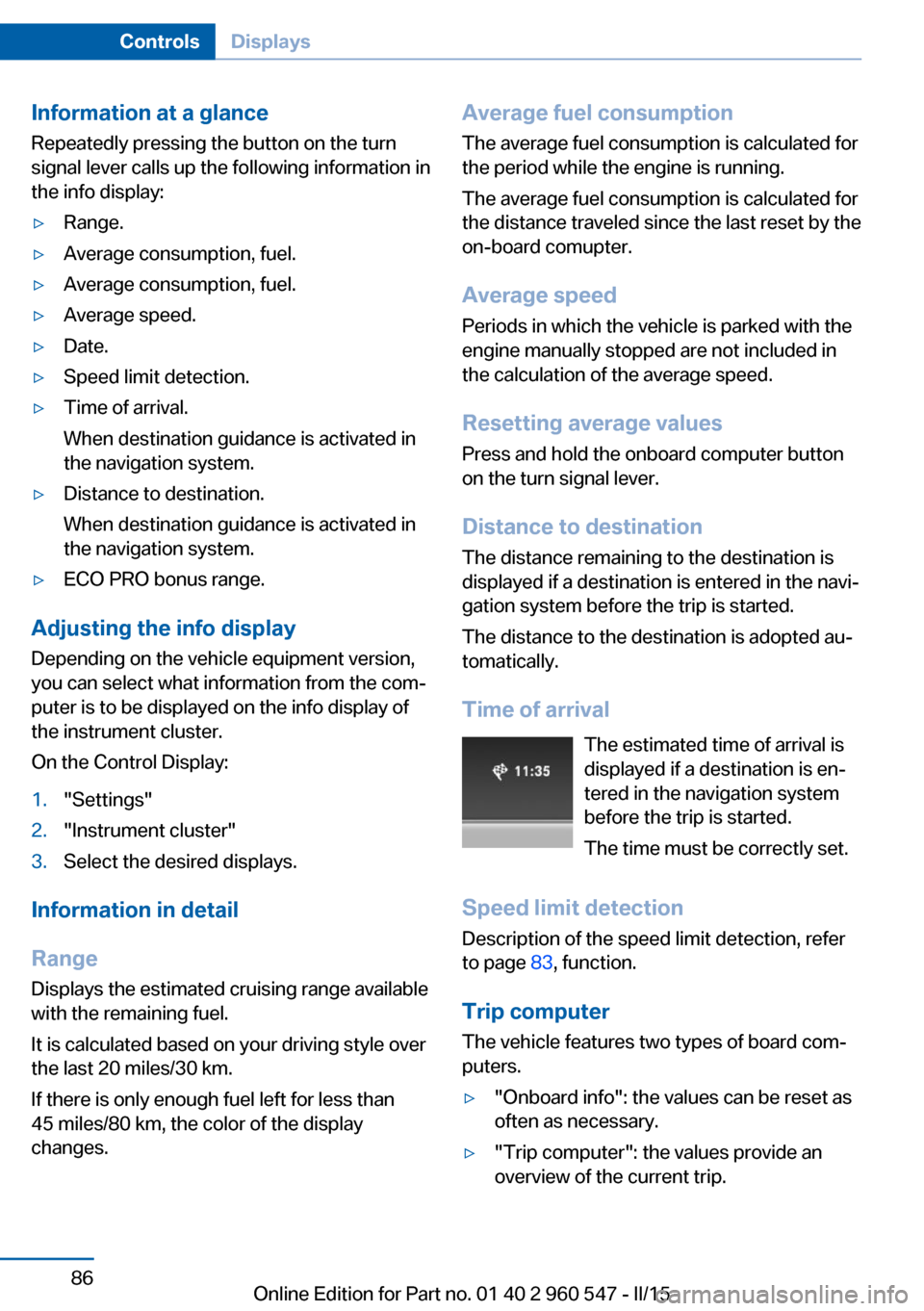
Information at a glanceRepeatedly pressing the button on the turn
signal lever calls up the following information in
the info display:‚Ė∑Range.‚Ė∑Average consumption, fuel.‚Ė∑Average consumption, fuel.‚Ė∑Average speed.‚Ė∑Date.‚Ė∑Speed limit detection.‚Ė∑Time of arrival.
When destination guidance is activated in
the navigation system.‚Ė∑Distance to destination.
When destination guidance is activated in
the navigation system.‚Ė∑ECO PRO bonus range.
Adjusting the info display
Depending on the vehicle equipment version,
you can select what information from the com‚Äź
puter is to be displayed on the info display of
the instrument cluster.
On the Control Display:
1."Settings"2."Instrument cluster"3.Select the desired displays.
Information in detail
Range
Displays the estimated cruising range available
with the remaining fuel.
It is calculated based on your driving style over
the last 20 miles/30 km.
If there is only enough fuel left for less than
45 miles/80 km, the color of the display
changes.
Average fuel consumption
The average fuel consumption is calculated for
the period while the engine is running.
The average fuel consumption is calculated for
the distance traveled since the last reset by the
on-board comupter.
Average speed
Periods in which the vehicle is parked with the
engine manually stopped are not included in
the calculation of the average speed.
Resetting average values Press and hold the onboard computer button
on the turn signal lever.
Distance to destination
The distance remaining to the destination is
displayed if a destination is entered in the navi‚Äź
gation system before the trip is started.
The distance to the destination is adopted au‚Äź
tomatically.
Time of arrival The estimated time of arrival is
displayed if a destination is en‚Äź
tered in the navigation system
before the trip is started.
The time must be correctly set.
Speed limit detection
Description of the speed limit detection, refer
to page 83, function.
Trip computer
The vehicle features two types of board com‚Äź
puters.‚Ė∑"Onboard info": the values can be reset as
often as necessary.‚Ė∑"Trip computer": the values provide an
overview of the current trip.Seite 86ControlsDisplays86
Online Edition for Part no. 01 40 2 960 547 - II/15
Page 105 of 247
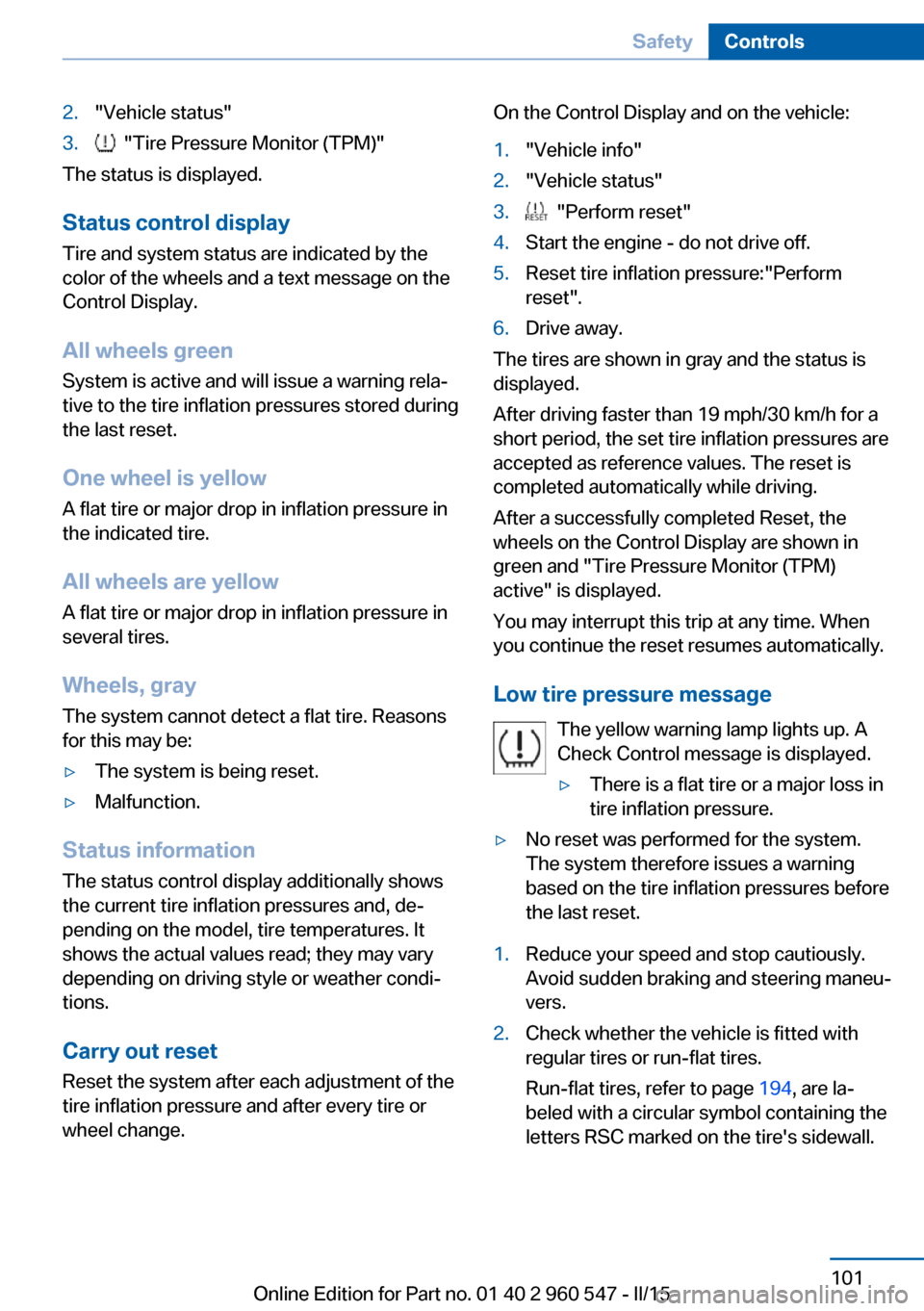
2."Vehicle status"3. "Tire Pressure Monitor (TPM)"
The status is displayed.
Status control display Tire and system status are indicated by the
color of the wheels and a text message on the
Control Display.
All wheels green System is active and will issue a warning rela‚Äź
tive to the tire inflation pressures stored during
the last reset.
One wheel is yellow A flat tire or major drop in inflation pressure in
the indicated tire.
All wheels are yellow A flat tire or major drop in inflation pressure in
several tires.
Wheels, gray The system cannot detect a flat tire. Reasons
for this may be:
‚Ė∑The system is being reset.‚Ė∑Malfunction.
Status information
The status control display additionally shows
the current tire inflation pressures and, de‚Äź
pending on the model, tire temperatures. It
shows the actual values read; they may vary depending on driving style or weather condi‚Äź
tions.
Carry out reset Reset the system after each adjustment of the
tire inflation pressure and after every tire or
wheel change.
On the Control Display and on the vehicle:1."Vehicle info"2."Vehicle status"3. "Perform reset"4.Start the engine - do not drive off.5.Reset tire inflation pressure:"Perform
reset".6.Drive away.
The tires are shown in gray and the status is
displayed.
After driving faster than 19 mph/30 km/h for a
short period, the set tire inflation pressures are
accepted as reference values. The reset is
completed automatically while driving.
After a successfully completed Reset, the
wheels on the Control Display are shown in
green and "Tire Pressure Monitor (TPM)
active" is displayed.
You may interrupt this trip at any time. When
you continue the reset resumes automatically.
Low tire pressure message The yellow warning lamp lights up. A
Check Control message is displayed.
‚Ė∑There is a flat tire or a major loss in
tire inflation pressure.‚Ė∑No reset was performed for the system.
The system therefore issues a warning
based on the tire inflation pressures before
the last reset.1.Reduce your speed and stop cautiously.
Avoid sudden braking and steering maneu‚Äź
vers.2.Check whether the vehicle is fitted with
regular tires or run-flat tires.
Run-flat tires, refer to page 194, are la‚Äź
beled with a circular symbol containing the
letters RSC marked on the tire's sidewall.Seite 101SafetyControls101
Online Edition for Part no. 01 40 2 960 547 - II/15
Page 108 of 247
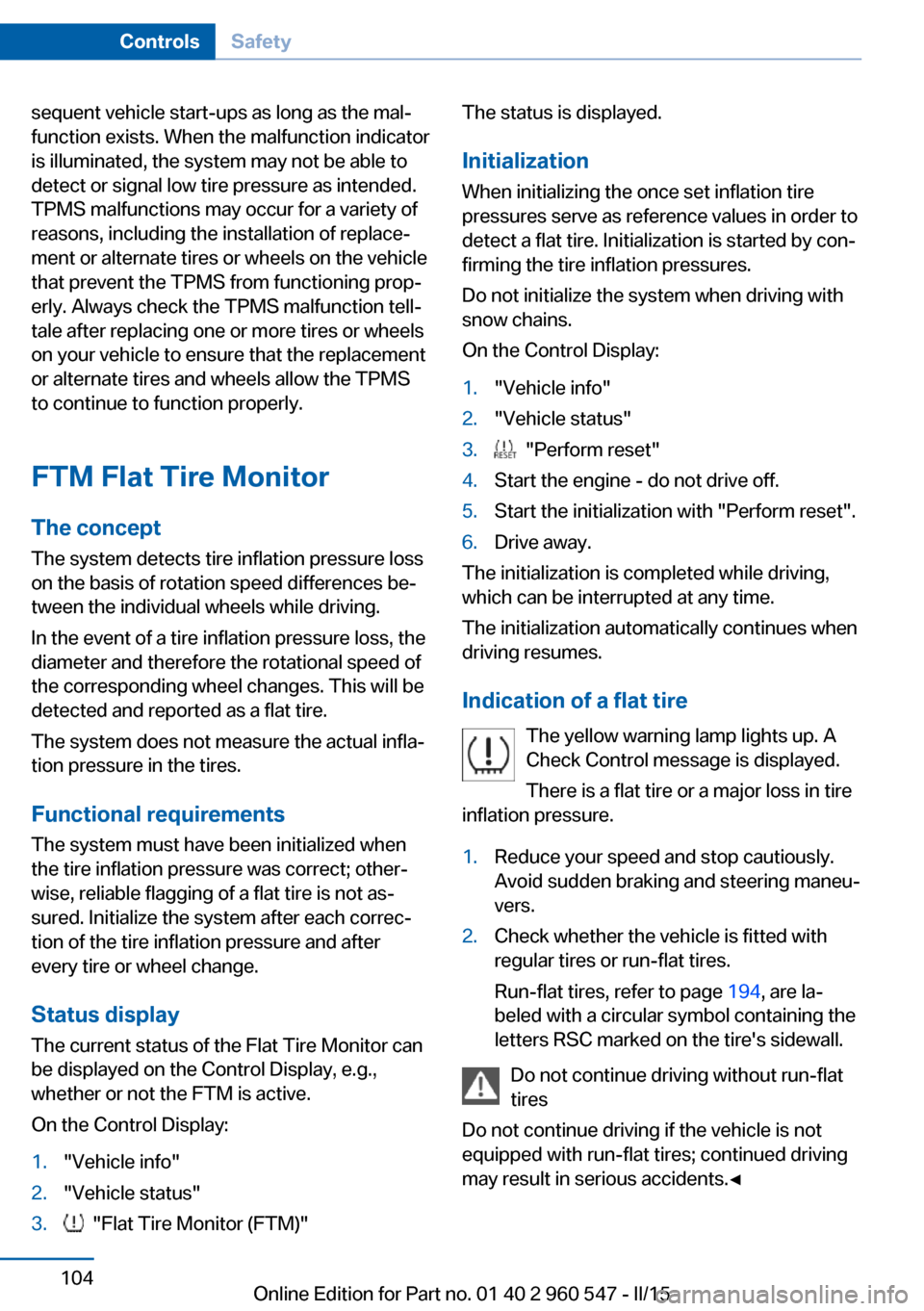
sequent vehicle start-ups as long as the mal‚Äź
function exists. When the malfunction indicator
is illuminated, the system may not be able to
detect or signal low tire pressure as intended.
TPMS malfunctions may occur for a variety of
reasons, including the installation of replace‚Äź
ment or alternate tires or wheels on the vehicle
that prevent the TPMS from functioning prop‚Äź
erly. Always check the TPMS malfunction tell‚Äź
tale after replacing one or more tires or wheels
on your vehicle to ensure that the replacement
or alternate tires and wheels allow the TPMS
to continue to function properly.
FTM Flat Tire Monitor The conceptThe system detects tire inflation pressure losson the basis of rotation speed differences be‚Äź
tween the individual wheels while driving.
In the event of a tire inflation pressure loss, the
diameter and therefore the rotational speed of
the corresponding wheel changes. This will be
detected and reported as a flat tire.
The system does not measure the actual infla‚Äź
tion pressure in the tires.
Functional requirements
The system must have been initialized when
the tire inflation pressure was correct; other‚Äź
wise, reliable flagging of a flat tire is not as‚Äź
sured. Initialize the system after each correc‚Äź tion of the tire inflation pressure and after
every tire or wheel change.
Status display
The current status of the Flat Tire Monitor can
be displayed on the Control Display, e.g.,
whether or not the FTM is active.
On the Control Display:1."Vehicle info"2."Vehicle status"3. "Flat Tire Monitor (FTM)"The status is displayed.
Initialization
When initializing the once set inflation tire
pressures serve as reference values in order to
detect a flat tire. Initialization is started by con‚Äź
firming the tire inflation pressures.
Do not initialize the system when driving with
snow chains.
On the Control Display:1."Vehicle info"2."Vehicle status"3. "Perform reset"4.Start the engine - do not drive off.5.Start the initialization with "Perform reset".6.Drive away.
The initialization is completed while driving,
which can be interrupted at any time.
The initialization automatically continues when
driving resumes.
Indication of a flat tire The yellow warning lamp lights up. A
Check Control message is displayed.
There is a flat tire or a major loss in tire
inflation pressure.
1.Reduce your speed and stop cautiously.
Avoid sudden braking and steering maneu‚Äź
vers.2.Check whether the vehicle is fitted with
regular tires or run-flat tires.
Run-flat tires, refer to page 194, are la‚Äź
beled with a circular symbol containing the
letters RSC marked on the tire's sidewall.
Do not continue driving without run-flat
tires
Do not continue driving if the vehicle is not
equipped with run-flat tires; continued driving
may result in serious accidents.‚óÄ
Seite 104ControlsSafety104
Online Edition for Part no. 01 40 2 960 547 - II/15
Page 110 of 247
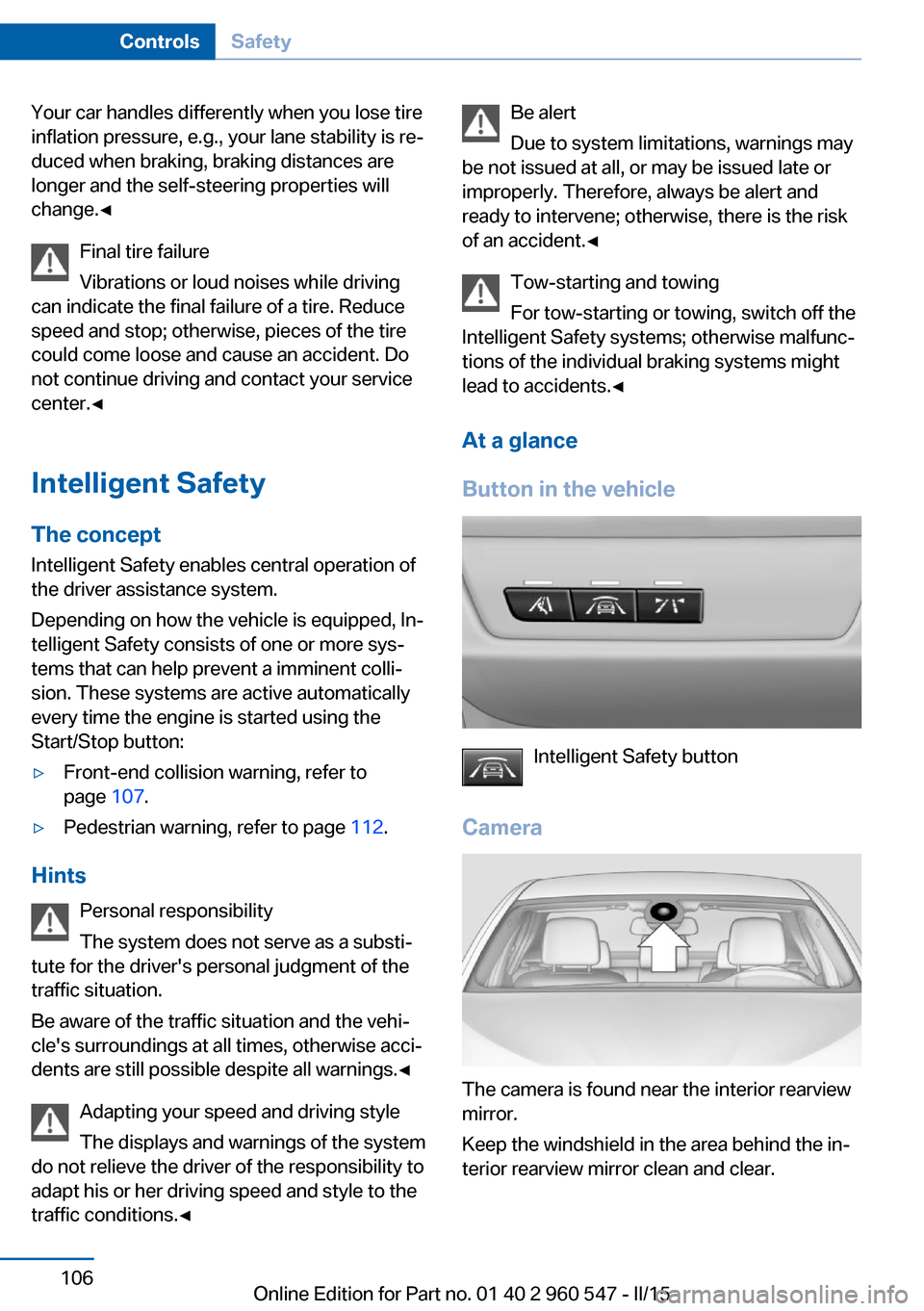
Your car handles differently when you lose tire
inflation pressure, e.g., your lane stability is re‚Äź
duced when braking, braking distances are
longer and the self-steering properties will
change.‚óÄ
Final tire failure
Vibrations or loud noises while driving
can indicate the final failure of a tire. Reduce
speed and stop; otherwise, pieces of the tire
could come loose and cause an accident. Do
not continue driving and contact your service
center.‚óÄ
Intelligent Safety
The concept Intelligent Safety enables central operation of
the driver assistance system.
Depending on how the vehicle is equipped, In‚Äź
telligent Safety consists of one or more sys‚Äź
tems that can help prevent a imminent colli‚Äź
sion. These systems are active automatically
every time the engine is started using the
Start/Stop button:‚Ė∑Front-end collision warning, refer to
page 107.‚Ė∑Pedestrian warning, refer to page 112.
Hints
Personal responsibility
The system does not serve as a substi‚Äź
tute for the driver's personal judgment of the
traffic situation.
Be aware of the traffic situation and the vehi‚Äź
cle's surroundings at all times, otherwise acci‚Äź
dents are still possible despite all warnings.‚óÄ
Adapting your speed and driving style
The displays and warnings of the system
do not relieve the driver of the responsibility to
adapt his or her driving speed and style to the
traffic conditions.‚óÄ
Be alert
Due to system limitations, warnings may
be not issued at all, or may be issued late or
improperly. Therefore, always be alert and
ready to intervene; otherwise, there is the risk
of an accident.‚óÄ
Tow-starting and towing
For tow-starting or towing, switch off the
Intelligent Safety systems; otherwise malfunc‚Äź
tions of the individual braking systems might
lead to accidents.‚óÄ
At a glance
Button in the vehicle
Intelligent Safety button
Camera
The camera is found near the interior rearview
mirror.
Keep the windshield in the area behind the in‚Äź
terior rearview mirror clean and clear.
Seite 106ControlsSafety106
Online Edition for Part no. 01 40 2 960 547 - II/15
Page 113 of 247
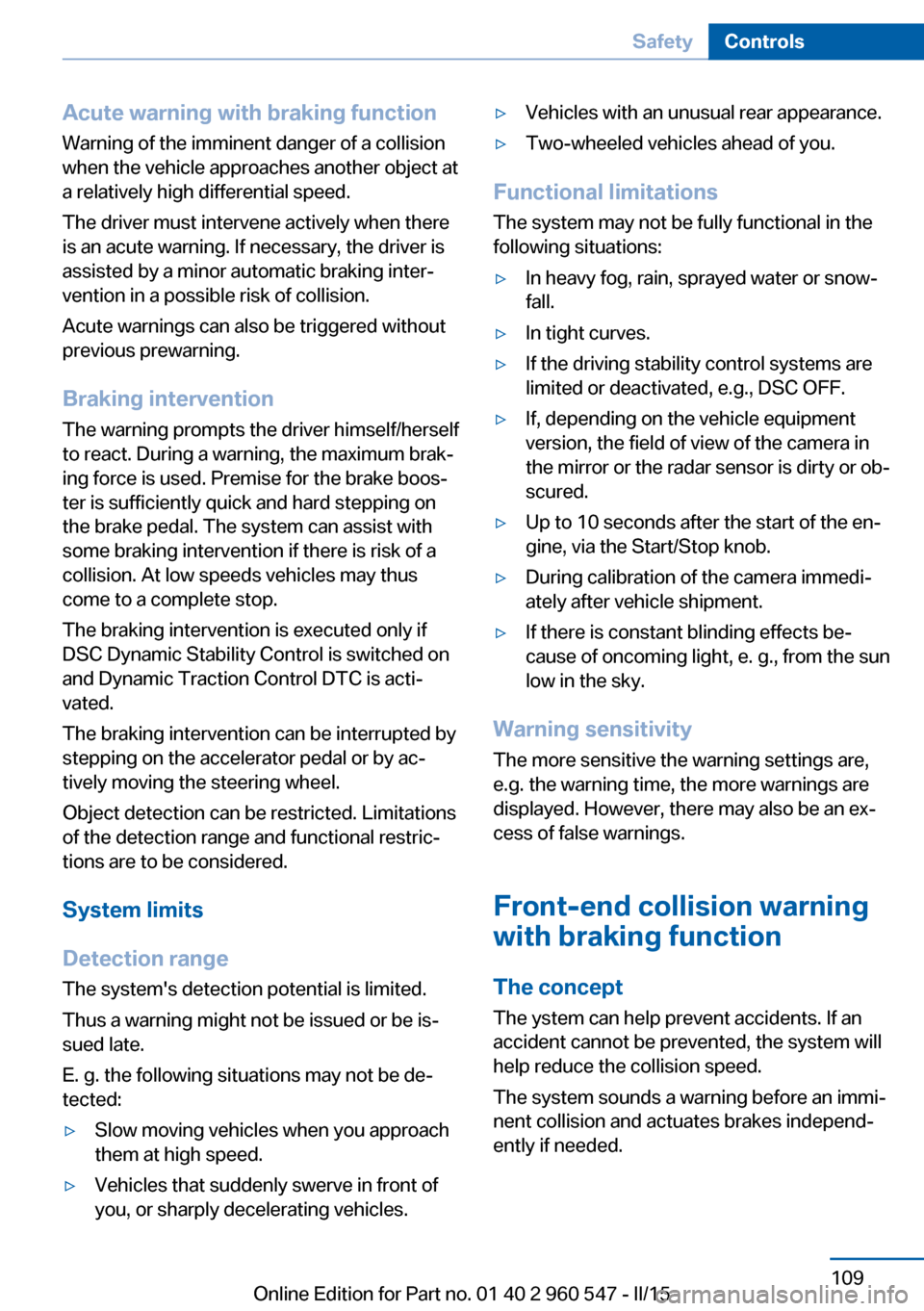
Acute warning with braking function
Warning of the imminent danger of a collision
when the vehicle approaches another object at
a relatively high differential speed.
The driver must intervene actively when there
is an acute warning. If necessary, the driver is
assisted by a minor automatic braking inter‚Äź
vention in a possible risk of collision.
Acute warnings can also be triggered without
previous prewarning.
Braking intervention
The warning prompts the driver himself/herself
to react. During a warning, the maximum brak‚Äź
ing force is used. Premise for the brake boos‚Äź
ter is sufficiently quick and hard stepping on
the brake pedal. The system can assist with
some braking intervention if there is risk of a
collision. At low speeds vehicles may thus
come to a complete stop.
The braking intervention is executed only if
DSC Dynamic Stability Control is switched on
and Dynamic Traction Control DTC is acti‚Äź
vated.
The braking intervention can be interrupted by
stepping on the accelerator pedal or by ac‚Äź
tively moving the steering wheel.
Object detection can be restricted. Limitations
of the detection range and functional restric‚Äź
tions are to be considered.
System limits
Detection range
The system's detection potential is limited.
Thus a warning might not be issued or be is‚Äź
sued late.
E. g. the following situations may not be de‚Äź
tected:‚Ė∑Slow moving vehicles when you approach
them at high speed.‚Ė∑Vehicles that suddenly swerve in front of
you, or sharply decelerating vehicles.‚Ė∑Vehicles with an unusual rear appearance.‚Ė∑Two-wheeled vehicles ahead of you.
Functional limitations
The system may not be fully functional in the
following situations:
‚Ė∑In heavy fog, rain, sprayed water or snow‚Äź
fall.‚Ė∑In tight curves.‚Ė∑If the driving stability control systems are
limited or deactivated, e.g., DSC OFF.‚Ė∑If, depending on the vehicle equipment
version, the field of view of the camera in
the mirror or the radar sensor is dirty or ob‚Äź
scured.‚Ė∑Up to 10 seconds after the start of the en‚Äź
gine, via the Start/Stop knob.‚Ė∑During calibration of the camera immedi‚Äź
ately after vehicle shipment.‚Ė∑If there is constant blinding effects be‚Äź
cause of oncoming light, e. g., from the sun
low in the sky.
Warning sensitivity
The more sensitive the warning settings are,
e.g. the warning time, the more warnings are
displayed. However, there may also be an ex‚Äź
cess of false warnings.
Front-end collision warning
with braking function
The concept The ystem can help prevent accidents. If an
accident cannot be prevented, the system will help reduce the collision speed.
The system sounds a warning before an immi‚Äź
nent collision and actuates brakes independ‚Äź
ently if needed.
Seite 109SafetyControls109
Online Edition for Part no. 01 40 2 960 547 - II/15
Page 114 of 247
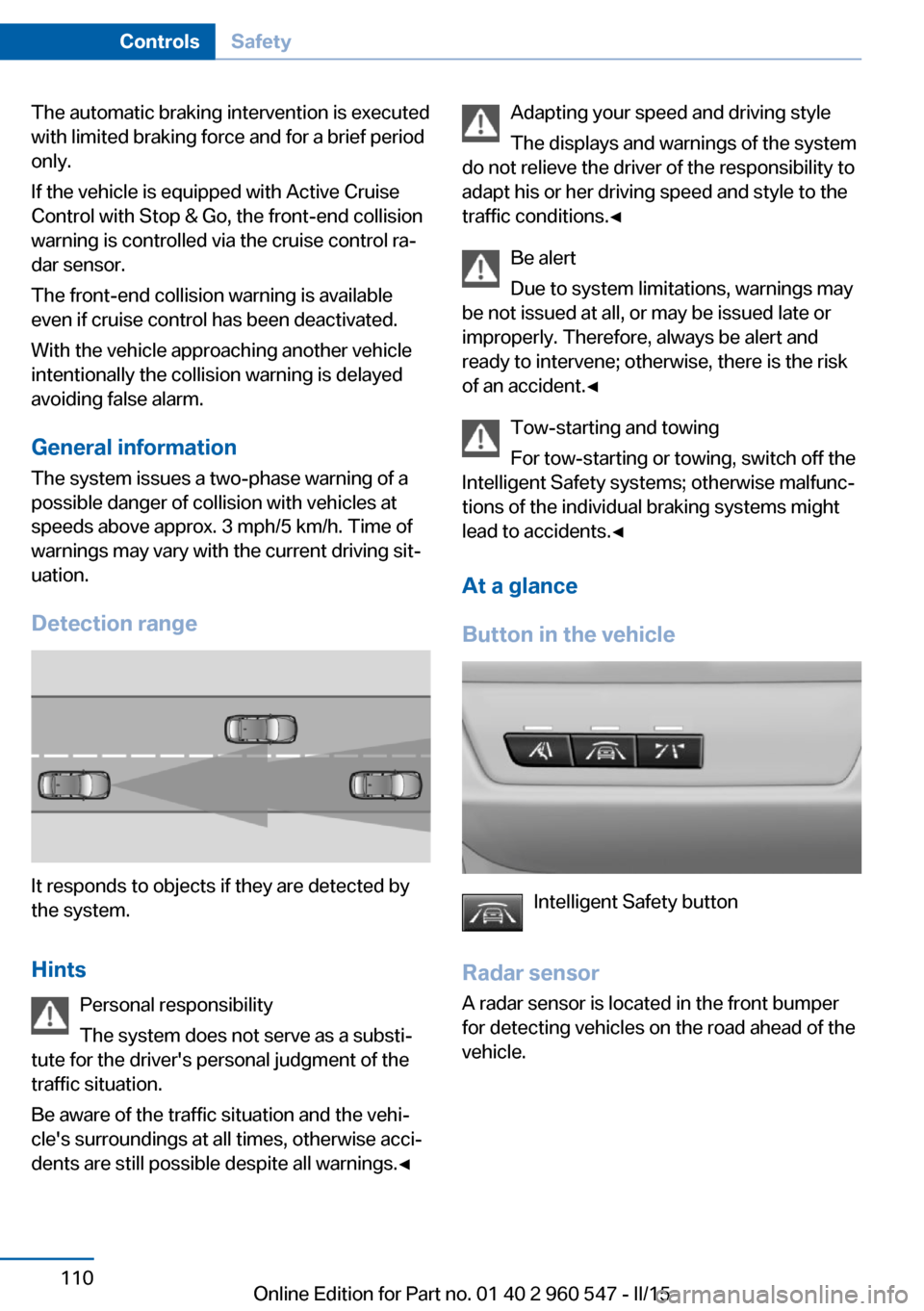
The automatic braking intervention is executed
with limited braking force and for a brief period
only.
If the vehicle is equipped with Active Cruise
Control with Stop & Go, the front-end collision
warning is controlled via the cruise control ra‚Äź
dar sensor.
The front-end collision warning is available
even if cruise control has been deactivated.
With the vehicle approaching another vehicle
intentionally the collision warning is delayed
avoiding false alarm.
General information
The system issues a two-phase warning of a
possible danger of collision with vehicles at
speeds above approx. 3 mph/5 km/h. Time of
warnings may vary with the current driving sit‚Äź
uation.
Detection range
It responds to objects if they are detected by
the system.
Hints Personal responsibility
The system does not serve as a substi‚Äź
tute for the driver's personal judgment of the
traffic situation.
Be aware of the traffic situation and the vehi‚Äź
cle's surroundings at all times, otherwise acci‚Äź
dents are still possible despite all warnings.‚óÄ
Adapting your speed and driving style
The displays and warnings of the system
do not relieve the driver of the responsibility to
adapt his or her driving speed and style to the
traffic conditions.‚óÄ
Be alert
Due to system limitations, warnings may
be not issued at all, or may be issued late or
improperly. Therefore, always be alert and
ready to intervene; otherwise, there is the risk
of an accident.‚óÄ
Tow-starting and towing
For tow-starting or towing, switch off the
Intelligent Safety systems; otherwise malfunc‚Äź
tions of the individual braking systems might
lead to accidents.‚óÄ
At a glance
Button in the vehicle
Intelligent Safety button
Radar sensor
A radar sensor is located in the front bumper
for detecting vehicles on the road ahead of the
vehicle.
Seite 110ControlsSafety110
Online Edition for Part no. 01 40 2 960 547 - II/15
Page 118 of 247
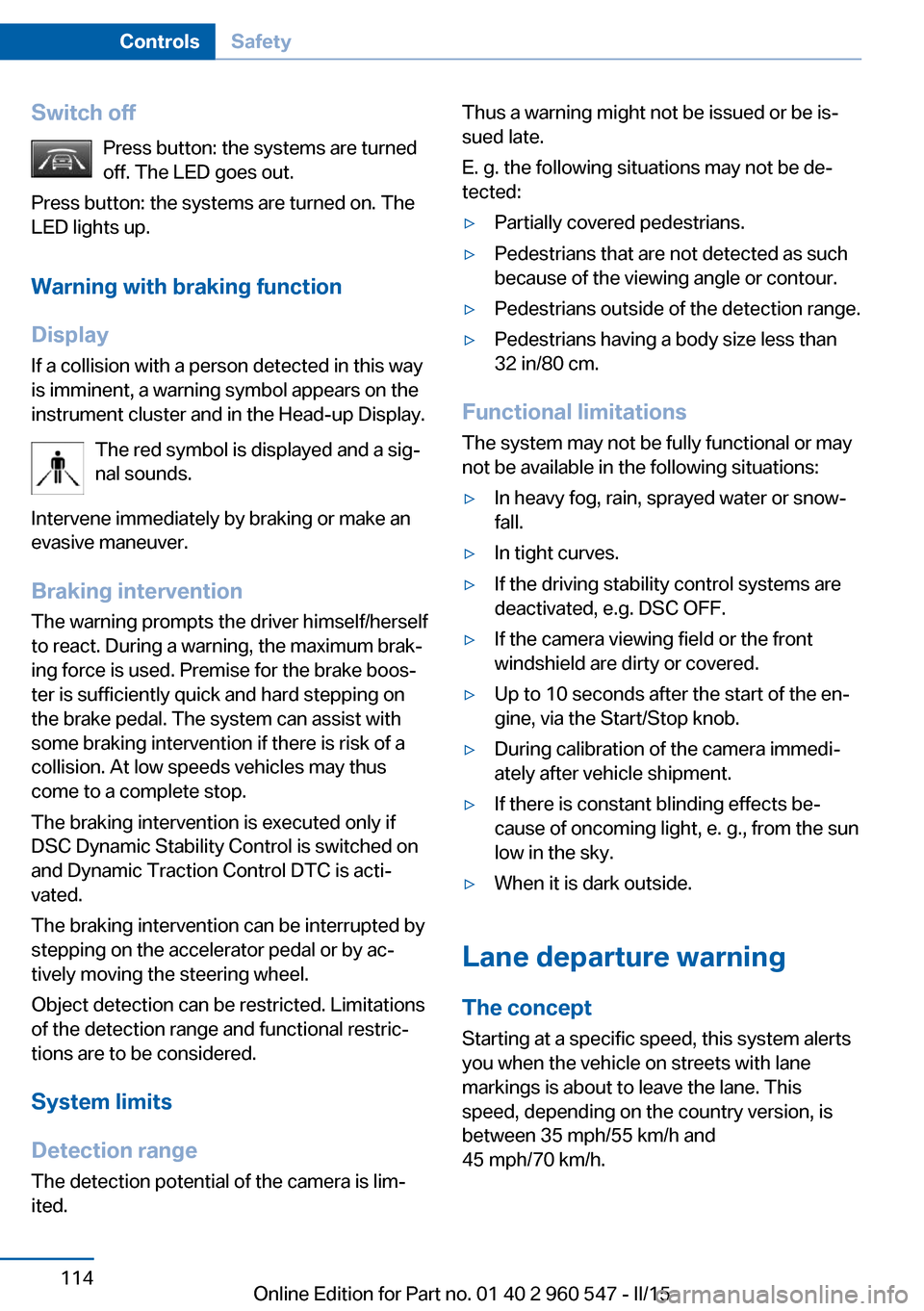
Switch offPress button: the systems are turned
off. The LED goes out.
Press button: the systems are turned on. The
LED lights up.
Warning with braking function
Display
If a collision with a person detected in this way
is imminent, a warning symbol appears on the
instrument cluster and in the Head-up Display.
The red symbol is displayed and a sig‚Äź
nal sounds.
Intervene immediately by braking or make an
evasive maneuver.
Braking intervention
The warning prompts the driver himself/herself
to react. During a warning, the maximum brak‚Äź
ing force is used. Premise for the brake boos‚Äź
ter is sufficiently quick and hard stepping on
the brake pedal. The system can assist with
some braking intervention if there is risk of a
collision. At low speeds vehicles may thus
come to a complete stop.
The braking intervention is executed only if
DSC Dynamic Stability Control is switched on
and Dynamic Traction Control DTC is acti‚Äź
vated.
The braking intervention can be interrupted by
stepping on the accelerator pedal or by ac‚Äź
tively moving the steering wheel.
Object detection can be restricted. Limitations
of the detection range and functional restric‚Äź
tions are to be considered.
System limits
Detection range
The detection potential of the camera is lim‚Äź
ited.Thus a warning might not be issued or be is‚Äź
sued late.
E. g. the following situations may not be de‚Äź
tected:‚Ė∑Partially covered pedestrians.‚Ė∑Pedestrians that are not detected as such
because of the viewing angle or contour.‚Ė∑Pedestrians outside of the detection range.‚Ė∑Pedestrians having a body size less than
32 in/80 cm.
Functional limitations
The system may not be fully functional or may
not be available in the following situations:
‚Ė∑In heavy fog, rain, sprayed water or snow‚Äź
fall.‚Ė∑In tight curves.‚Ė∑If the driving stability control systems are
deactivated, e.g. DSC OFF.‚Ė∑If the camera viewing field or the front
windshield are dirty or covered.‚Ė∑Up to 10 seconds after the start of the en‚Äź
gine, via the Start/Stop knob.‚Ė∑During calibration of the camera immedi‚Äź
ately after vehicle shipment.‚Ė∑If there is constant blinding effects be‚Äź
cause of oncoming light, e. g., from the sun
low in the sky.‚Ė∑When it is dark outside.
Lane departure warning
The concept Starting at a specific speed, this system alerts
you when the vehicle on streets with lane
markings is about to leave the lane. This
speed, depending on the country version, is
between 35 mph/55 km/h and
45 mph/70 km/h.
Seite 114ControlsSafety114
Online Edition for Part no. 01 40 2 960 547 - II/15
Page 123 of 247
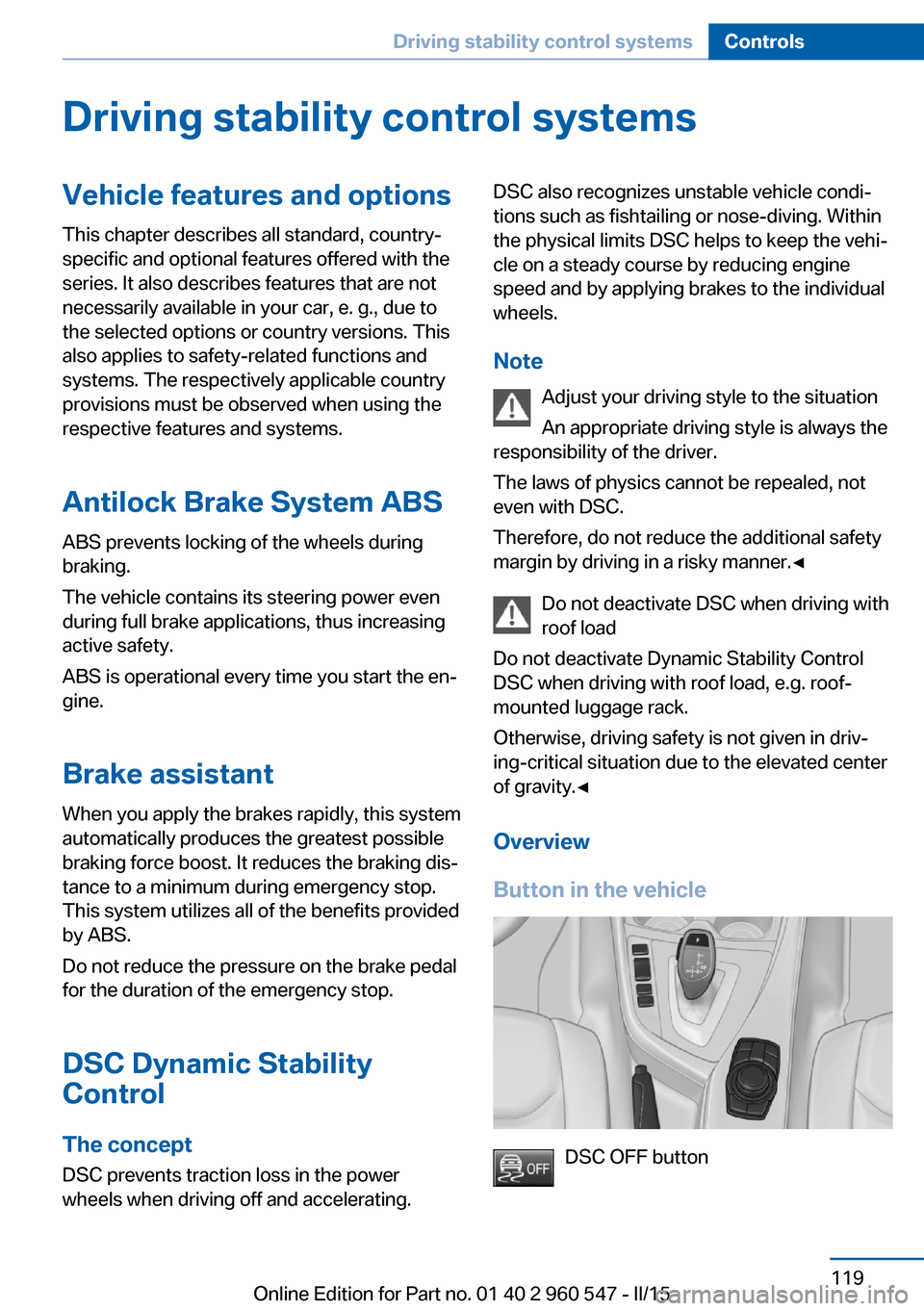
Driving stability control systemsVehicle features and optionsThis chapter describes all standard, country-
specific and optional features offered with the
series. It also describes features that are not
necessarily available in your car, e. g., due to
the selected options or country versions. This
also applies to safety-related functions and
systems. The respectively applicable country
provisions must be observed when using the
respective features and systems.
Antilock Brake System ABS ABS prevents locking of the wheels during
braking.
The vehicle contains its steering power even
during full brake applications, thus increasing
active safety.
ABS is operational every time you start the en‚Äź
gine.
Brake assistant When you apply the brakes rapidly, this system
automatically produces the greatest possible
braking force boost. It reduces the braking dis‚Äź
tance to a minimum during emergency stop.
This system utilizes all of the benefits provided
by ABS.
Do not reduce the pressure on the brake pedal
for the duration of the emergency stop.
DSC Dynamic Stability
Control
The concept DSC prevents traction loss in the power
wheels when driving off and accelerating.DSC also recognizes unstable vehicle condi‚Äź
tions such as fishtailing or nose-diving. Within
the physical limits DSC helps to keep the vehi‚Äź
cle on a steady course by reducing engine
speed and by applying brakes to the individual
wheels.
Note Adjust your driving style to the situation
An appropriate driving style is always the
responsibility of the driver.
The laws of physics cannot be repealed, not
even with DSC.
Therefore, do not reduce the additional safety
margin by driving in a risky manner.‚óÄ
Do not deactivate DSC when driving with
roof load
Do not deactivate Dynamic Stability Control DSC when driving with roof load, e.g. roof-
mounted luggage rack.
Otherwise, driving safety is not given in driv‚Äź
ing-critical situation due to the elevated center
of gravity.‚óÄ
Overview
Button in the vehicle
DSC OFF button
Seite 119Driving stability control systemsControls119
Online Edition for Part no. 01 40 2 960 547 - II/15
Page 145 of 247
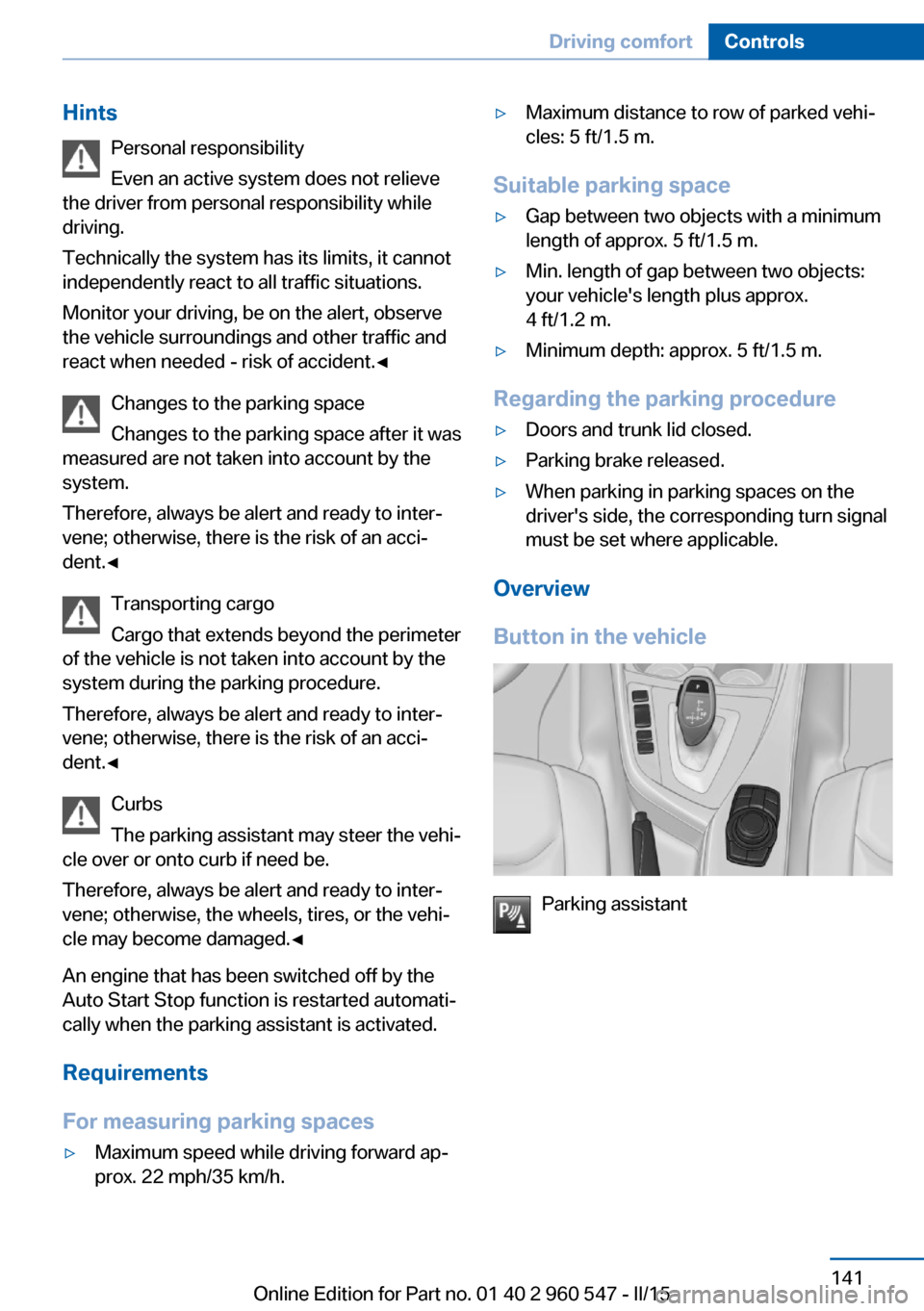
HintsPersonal responsibility
Even an active system does not relieve
the driver from personal responsibility while
driving.
Technically the system has its limits, it cannot
independently react to all traffic situations.
Monitor your driving, be on the alert, observe
the vehicle surroundings and other traffic and
react when needed - risk of accident.‚óÄ
Changes to the parking space
Changes to the parking space after it was
measured are not taken into account by the system.
Therefore, always be alert and ready to inter‚Äź
vene; otherwise, there is the risk of an acci‚Äź
dent.‚óÄ
Transporting cargo
Cargo that extends beyond the perimeter
of the vehicle is not taken into account by the
system during the parking procedure.
Therefore, always be alert and ready to inter‚Äź
vene; otherwise, there is the risk of an acci‚Äź
dent.‚óÄ
Curbs
The parking assistant may steer the vehi‚Äź
cle over or onto curb if need be.
Therefore, always be alert and ready to inter‚Äź
vene; otherwise, the wheels, tires, or the vehi‚Äź
cle may become damaged.‚óÄ
An engine that has been switched off by the
Auto Start Stop function is restarted automati‚Äź
cally when the parking assistant is activated.
Requirements
For measuring parking spaces‚Ė∑Maximum speed while driving forward ap‚Äź
prox. 22 mph/35 km/h.‚Ė∑Maximum distance to row of parked vehi‚Äź
cles: 5 ft/1.5 m.
Suitable parking space
‚Ė∑Gap between two objects with a minimum
length of approx. 5 ft/1.5 m.‚Ė∑Min. length of gap between two objects:
your vehicle's length plus approx.
4 ft/1.2 m.‚Ė∑Minimum depth: approx. 5 ft/1.5 m.
Regarding the parking procedure
‚Ė∑Doors and trunk lid closed.‚Ė∑Parking brake released.‚Ė∑When parking in parking spaces on the
driver's side, the corresponding turn signal
must be set where applicable.
Overview
Button in the vehicle
Parking assistant
Seite 141Driving comfortControls141
Online Edition for Part no. 01 40 2 960 547 - II/15
Page 178 of 247
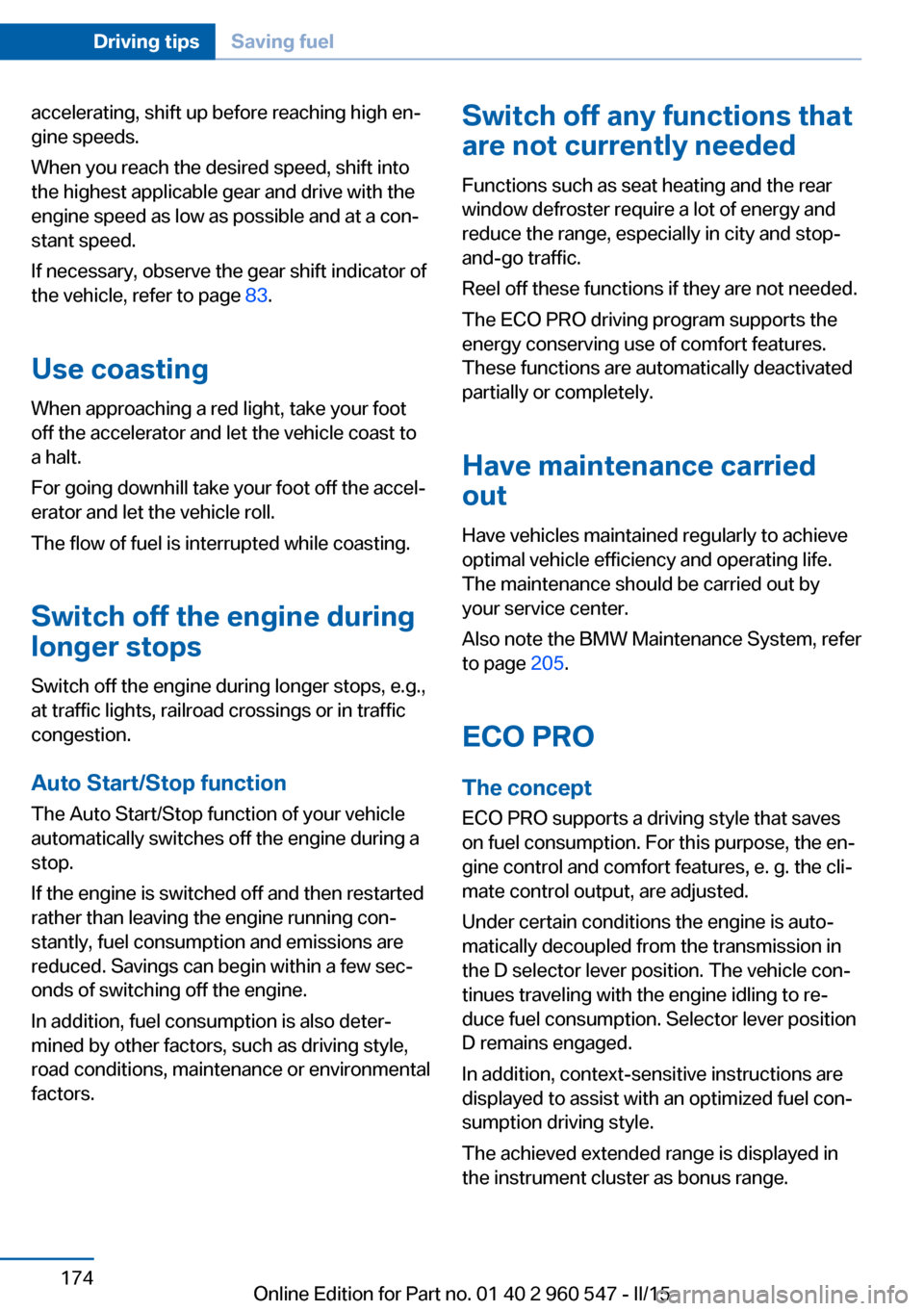
accelerating, shift up before reaching high en‚Äź
gine speeds.
When you reach the desired speed, shift into
the highest applicable gear and drive with the
engine speed as low as possible and at a con‚Äź
stant speed.
If necessary, observe the gear shift indicator of
the vehicle, refer to page 83.
Use coasting When approaching a red light, take your foot
off the accelerator and let the vehicle coast to
a halt.
For going downhill take your foot off the accel‚Äź
erator and let the vehicle roll.
The flow of fuel is interrupted while coasting.
Switch off the engine during
longer stops
Switch off the engine during longer stops, e.g.,
at traffic lights, railroad crossings or in traffic
congestion.
Auto Start/Stop function The Auto Start/Stop function of your vehicle
automatically switches off the engine during a
stop.
If the engine is switched off and then restarted
rather than leaving the engine running con‚Äź
stantly, fuel consumption and emissions are
reduced. Savings can begin within a few sec‚Äź
onds of switching off the engine.
In addition, fuel consumption is also deter‚Äź
mined by other factors, such as driving style,
road conditions, maintenance or environmental
factors.Switch off any functions that
are not currently needed
Functions such as seat heating and the rear
window defroster require a lot of energy and
reduce the range, especially in city and stop-
and-go traffic.
Reel off these functions if they are not needed.
The ECO PRO driving program supports the
energy conserving use of comfort features.
These functions are automatically deactivated
partially or completely.
Have maintenance carried
out
Have vehicles maintained regularly to achieve
optimal vehicle efficiency and operating life.
The maintenance should be carried out by
your service center.
Also note the BMW Maintenance System, refer
to page 205.
ECO PRO
The concept
ECO PRO supports a driving style that saves
on fuel consumption. For this purpose, the en‚Äź
gine control and comfort features, e. g. the cli‚Äź
mate control output, are adjusted.
Under certain conditions the engine is auto‚Äź
matically decoupled from the transmission in
the D selector lever position. The vehicle con‚Äź
tinues traveling with the engine idling to re‚Äź
duce fuel consumption. Selector lever position
D remains engaged.
In addition, context-sensitive instructions are
displayed to assist with an optimized fuel con‚Äź
sumption driving style.
The achieved extended range is displayed in
the instrument cluster as bonus range.Seite 174Driving tipsSaving fuel174
Online Edition for Part no. 01 40 2 960 547 - II/15